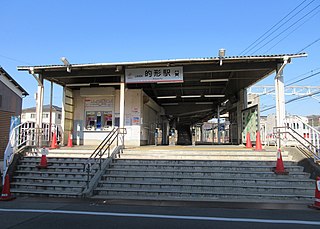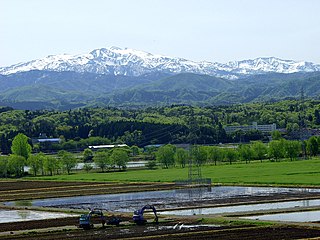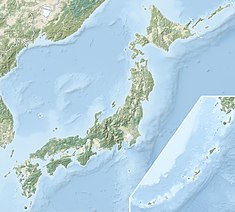
The Shin-Yokohama Rāmen Museum is a food court which opened in 1994, located in the Shin-Yokohama district of Kōhoku-ku, Yokohama, Japan.

The persimmon is the edible fruit of a number of species of trees in the genus Diospyros. The most widely cultivated of these is the Oriental persimmon, Diospyros kaki – among the most commonly human-grown fruit trees on Earth. Diospyros is in the family Ebenaceae, and a number of non-persimmon species of the genus are grown for ebony timber. In 2019, China produced 75% of the world total of persimmons.

The Defense Language Institute (DLI) is a United States Department of Defense (DoD) educational and research institution consisting of two separate entities which provide linguistic and cultural instruction to the Department of Defense, other federal agencies and numerous customers around the world. The Defense Language Institute is responsible for the Defense Language Program, and the bulk of the Defense Language Institute's activities involve educating DoD members in assigned languages, and international personnel in English. Other functions include planning, curriculum development, and research in second-language acquisition.

Hibakusha is a word of Japanese origin generally designating the people affected by the atomic bombings of Hiroshima and Nagasaki at the end of World War II.
Michihiko Hachiya was a Japanese physician who survived the Hiroshima bombing in 1945 and kept a diary of his experience. He was Director of the Hiroshima Communications Hospital and lived near the hospital, about a mile from the explosion's center. A 1984 editorial in the Journal of American Medical Association, indicates "At the urging of friends, Dr. Hachiya first published his diary in a small Japanese-language medical journal that circulated among medical members of the Japanese communications services. There it came to the attention of Warner Wells, MD, an American physician who was working in Japan in 1950 as a surgical consultant to the Atomic Bomb Casualty Commission." It was Dr. Wells, who in consultation with Dr. Hachiya, made the diary to be published in 1955, under the name of Hiroshima Diary.
Kim Hyon-hui, also known as Ok Hwa, is a North Korean former agent, responsible for the Korean Air Flight 858 bombing in 1987, which killed 115 people. She was arrested in Bahrain following the bombing and extradited to South Korea. There she was sentenced to death but later pardoned.

AT-rich interactive domain-containing protein 3A is a protein that in humans is encoded by the ARID3A gene.

Mori Yoshinari was a Japanese samurai of the Sengoku period and the head of the Mori clan (Genji) family, who served the Saitō clan. The Saitō were the lords of Mino province. Later, he become a retainer of Oda Nobunaga.

The Military Intelligence Service was a World War II U.S. military unit consisting of two branches, the Japanese American unit and the German-Austrian unit based at Camp Ritchie, best known as the "Ritchie Boys". The unit described here was primarily composed of Nisei who were trained as linguists. Graduates of the MIS language school (MISLS) were attached to other military units to provide translation, interpretation, and interrogation services.

Sakai Masahisa was a Japanese samurai of the Sengoku Period, who most notably served the Oda clan. He was born in Mino Province, and first served the Saitō clan. After the fall of the Saitō, he was taken on as a retainer by Oda Nobunaga.

Hachiya Yoritaka was a Japanese samurai of the Sengoku period who served the Oda clan. First he served the Toki clan and Saito clan. When Nobunaga started campaign on Mino Province, he became a vassal of Nobunaga as a member of "Kuro-horo-shu"
Unoshima was a town located in Chikujō District, Fukuoka Prefecture. In March 1935, the town merged with the town of Hachiya and dissolved. The town is now part of the city of Buzen.
Hachiya was a town located in Chikujō District, Fukuoka Prefecture. On 10 April 1955, the town merged with 8 villages to form the city of Unoshima. 4 days later, the city was renamed to the city of Buzen.

Matogata Station is a passenger railway station located in the city of Himeji, Hyōgo Prefecture, Japan, operated by the private Sanyo Electric Railway.

Albalophosaurus is a genus of ceratopsian ornithischian dinosaur. It was described in 2009 from remains found in 1997 by Yoshinori Kobayashi from the Kuwajima Formation of central Japan, outcropping in Hakusan in the Ishikawa Prefecture. The holotype, SBEI 176, consists of cranial bones from an incomplete, disarticulated skull and left lower jaw thought to belong to a single individual. The type species is named A. yamaguchiorum. The generic name is derived from Latin albus, "white", and Greek λόϕος (lophos), "crest", a reference to the snow-covered crest of Mount Hakusan. The specific name honours Ichio Yamaguchi and Mikiko Yamaguchi, who discovered and prepared many fossils from the site.
Hachiya Toshiyuki (蜂矢敏行) was a sumo wrestler from Motosu, Gifu, Japan. He made his professional debut in September 1968. He holds the record jointly with Oshio for the most tournaments fought in the juryo division, at 55. He spent four tournaments in the top makuuchi division, peaking at maegashira 6 in November 1984. At around 108 kg (238 lb) he was one of the lightest sekitori. He retired in 1987 and became an elder of the Japan Sumo Association under the name Onogawa until his death in 2001.

Gomen ne Seishun! (ごめんね青春!), also known as Saving My Stupid Youth, is a Japanese television drama written by Kankuro Kudo. The series was broadcast by TBS from 12 October to 21 December 2014.

Tsubasa to Hotaru is a Japanese manga series written and illustrated by Nana Haruta. Tsubasa to Hotaru was serialized in the monthly shōjo manga magazine Ribon from the September 2013 issue to the December 2017 issue. During the series' run, an anime adaptation was screened at Ribon Festa 2014 and episodes were later produced as animated segments in the children's variety show Oha Suta.

We Swore to Meet in the Next Life and That's When Things Got Weird! is a Japanese manga series written and illustrated by Hato Hachiya. It was serialized in the monthly shōjo manga magazine Zero-Sum Online since 2018.














